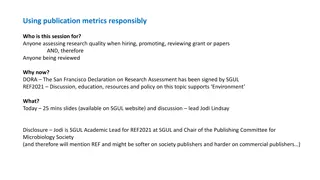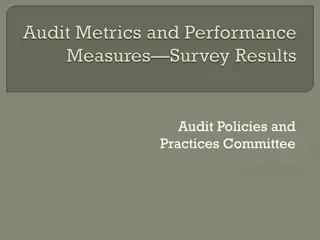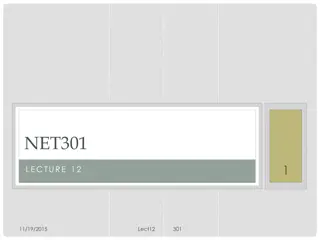Understanding Confusion Matrix and Performance Measurement Metrics
Explore the concept of confusion matrix, a crucial tool in evaluating the performance of classifiers. Learn about True Positive, False Negative, False Positive, and True Negative classifications. Dive into performance evaluation metrics like Accuracy, True Positive Rate, False Positive Rate, False Negative Rate, and True Negative Rate. Gain insights into measuring classifier effectiveness and efficiency with practical examples.
Download Presentation

Please find below an Image/Link to download the presentation.
The content on the website is provided AS IS for your information and personal use only. It may not be sold, licensed, or shared on other websites without obtaining consent from the author. Download presentation by click this link. If you encounter any issues during the download, it is possible that the publisher has removed the file from their server.
E N D
Presentation Transcript
1 Confusion Matrix & Performance Measurement Metrics Al Amin Biswas Lecturer, CSE, DIU
Confusion Matrix 2 A confusion matrix for a two classes (+, -) is shown below. There are four quadrants in the confusion matrix, which are symbolized as below. True Positive (TP: f++) : The number of instances that were positive (+) and correctly classified as positive (+). False Negative (FN: f+-): The number of instances that were positive (+) and incorrectly classified as negative (-). False Positive (FP: f-+): The number of instances that were negative (-) and incorrectly classified as (+). True Negative (TN: f--): The number of instances that were negative (-) and correctly classified as (-).
Confusion Matrix 3 Note: Np = TP (f++) + FN (f+-) = is the total number of positive instances. Nn = FP(f-+) + Tn(f--) = is the total number of negative instances. N = Np + Nn = is the total number of instances. (TP + TN) denotes the number of correct classification (FP + FN) denotes the number of errors in classification. For a perfect classifier, FP = FN = 0
Confusion Matrix Example 4 For example, Class + - + - 52 (TP) 21 (FP) 18 (FN) 123 (TN) Calculate the performance evaluation metrics
Accuracy 5 It is defined as the fraction of the number of examples that are correctly classified by the classifier to the total number of instances. ??+?? Accuracy= ??+??+??+??
Performance Evaluation Metrics 6 We now define a number of metrics for the measurement of a classifier. In our discussion, we shall make the assumptions that there are only two classes: + (positive) and (negative) True Positive Rate (TPR): It is defined as the fraction of the positive examples predicted correctly by the classifier. ??? =?? ?? ?++ ?= ??+??= ?+++?+ This metrics is also known as Recall, Sensitivity or Hit rate. False Positive Rate (FPR): It is defined as the fraction of negative examples classified as positive class by the classifier. ??? =?? ?? ? + ?= ?? + ??= ? ++?
Performance Evaluation Metrics 7 False Negative Rate (FNR): It is defined as the fraction of positive examples classified as a negative class by the classifier. ??? =?? ?? ?+ = ?? + ??= ? ?+++ ?+ True Negative Rate (TNR): It is defined as the fraction of negative examples classified correctly by the classifier ??? =?? ?? ? = ?? + ??= ? ? + ? + This metric is also known as Specificity.
Performance Evaluation Metrics 8 Both, Precision and Recall are defined by ?? ????????? = ?? + ?? ?? ?? + ?? ?????? =
Performance Evaluation Metrics 9 F1 Score (F1): Recall (r) and Precision (p) are two widely used metrics employed in analysis.. It is defined in terms of (r or Recall) and (p or Precision) as follows. ?1????? =2 ?????? .????????? ?????? + ????????? 2?? = 2?? + ?? + ?? Note F1 represents the harmonic mean between recall and precision High value of F1 score ensures that both Precision and Recall are reasonably high.
Analysis with Performance Measurement Metrics 10 Based on the various performance metrics, we can characterize a classifier. We do it in terms of TPR, FPR, Precision and Recall and Accuracy Case 1: Perfect Classifier When every instance is correctly classified, it is called the perfect classifier. In this case, TP = P, TN = N and CM is TPR = TP/(TP+FN)= ? ?=1 Predicted Class FPR = 0 + - ?=0 + P 0 Precision = ? ?= 1 1+1= 1 ?+? = 1 Actual class - 0 N F1Score = 2 1 Accuracy = ?+?
Analysis with Performance Measurement Metrics 11 Case 2: Worst Classifier When every instance is wrongly classified, it is called the worst classifier. In this case, TP = 0, TN = 0 and the CM is Predicted Class TPR = 0 + - ?=0 + 0 P Actual FPR = ? class ?= 1 - N 0 Precision = 0 ?= 0 F1Score = Not applicable as Recall + Precision = 0 0 Accuracy = ?+? = 0
Analysis with Performance Measurement Metrics 12 Case 3: Ultra-Liberal Classifier The classifier always predicts the + class correctly. Here, the False Negative (FN) and True Negative (TN) are zero. The CM is Predicted Class + - TPR = ? ?= 1 + P 0 Actual class FPR = ? ?= 1 - N 0 ? Precision = ?+? 2? F1Score = 2?+? ? Accuracy = ?+? = 0
Analysis with Performance Measurement Metrics 13 Case 4: Ultra-Conservative Classifier This classifier always predicts the - class correctly. Here, the False Negative (FN) and True Negative (TN) are zero. The CM is Predicted Class + - TPR = 0 ?= 0 + 0 p Actual class FPR = 0 ?= 0 - 0 N Precision = Not applicable (as TP + FP = 0) F1Score = Not applicable ? Accuracy = ?+? = 0























